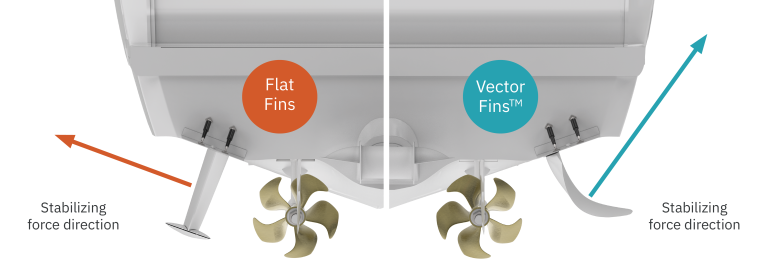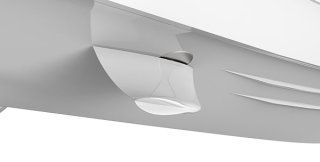How Vector Fins™ work at anchor and underway
The vertical concave shape of the Vector Fins™ creates a net force direction, both underway and at anchor. This means the work is more up and down in differs from side to side like flat fins, that work with forces parallel to the hull angle.
Up to 50% more efficient at anchor than flat fins
As many professional sea men spend much of their time at low speeds, the stabilization system must perform well at any speed, including at anchor. A stabilized boat offers a significant increase in onboard well-being.
Up to 30% more efficient underway than flat fins
Extensive testing has shown that Vector Fins™ roll reduction efficiency is significantly improved by 30% compared to flat fins of the same size.
As mentioned in the introduction, the concave shape creates a net force direction both during speed and when the boat is anchored. In practice, Vector Fins™ work up and down instead of side to side like flat fins, which work with forces parallel to the hull angle.
What about compared to gyro stabilizers?
Gyro stabilizers always have the same maximum total force they can apply to reduce roll, independent of boat speed or roll periods. Fin stabilizers increase their stabilization force by speed and roll periods when cruising.
Due to Vector Fins' unmatched efficiency, the system can reduce the boat's uncomfortable rolling motion up to 95% while cruising, even in relatively large waves, keeping you and your crew comfortable and safe onboard.
How Vector Fins™ create lift
Loss of speed means added fuel cost. Vector Fins™ generally create as much lift as they add drag, resulting in virtually no loss of speed and no added fuel cost.

Changing the net force angle also increases the leverage arm around the boat's rolling point, further increasing the physical forces that work on the boat to reduce roll. This provides a lot more roll stabilization per fin size, which means that drag, power consumption, internal space occupation, and load on the mechanical parts are a lot less than other fins providing similar roll reduction.

